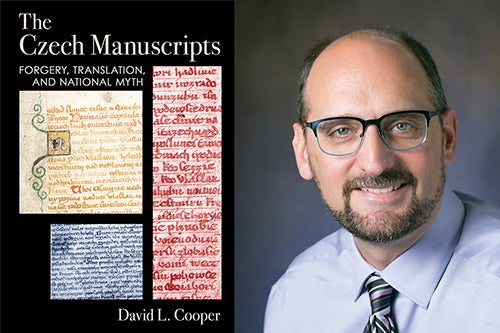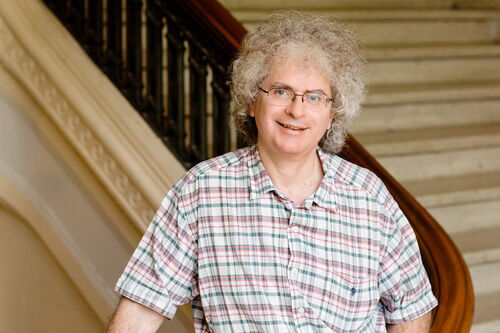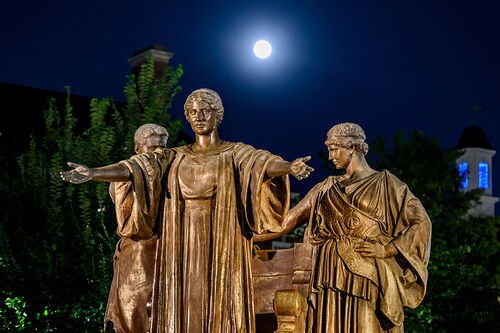Book examines role of famous forgeries in Czech cultural revival

Two manuscripts, purportedly from medieval times, played a large role in the 19th century Czech National Revival, serving as an important source of the nation’s mythology. But these influential documents that helped revitalize the Czech language and culture were fake.
Slavic languages and literatures professor David Cooper writes about the influence of the manuscripts and how they successfully functioned as genuine historical documents for so long in his new book “The Czech Manuscripts: Forgery, Translation, and National Myth.”
The Queen’s Court Manuscript and the Green Mountain Manuscript, “discovered” in 1817 and 1818, were the longest-lived literary forgeries of the Romantic period, with 70 years between their appearance and when they were definitively declared false. The manuscripts contained epic poems written in Old Czech, a form of the language no longer used, that described the Czechs as a democratic and peaceful people who nevertheless valiantly defended their homeland against invasions.
They were exactly the kind of documents that Czech nationalists were desperately searching for at the time, Cooper said.
Early 19th century Europe was a period of Romantic nationalism, when nations were looking to their origins to define themselves, their national character and their mission. “Everyone was unearthing old epic poems and stories about battles and moments when the national culture was coalescing,” Cooper said.
Czechs were looking for those materials as well, but they weren’t finding them. The scholars of the time assumed they had existed but were destroyed or lost in conflicts over the years, he said.
The forger is believed to be Czech nationalist Václav Hanka, working with others involved in the nationalist movement. The forgeries were based on Russian and Serbian materials from medieval times and imagined what corresponding Czech folklore would have looked like, Cooper said.
Hanka’s teacher, who was an expert on Slavic language and antiquities, immediately suspected the second manuscript was a forgery, but both were generally seen as authentic and were celebrated.
Even though they were ultimately found to be forgeries, they were important in helping recruit people to the Czech nationalist movement and encouraging them to write and speak in Czech, Cooper said. At the time, the region was part of the Hapsburg Empire and the Czech language was in danger of disappearing as German was the language used by scholars and taught in schools.
Czech nationalists adopted old Slavic names from the manuscripts, and they used their stories to define who they were as Czechs, Cooper said. For example, the Green Mountain Manuscript contains a story of an assembly with members taking a secret vote.
“In its earliest manifestation of creating a state, they went about it democratically. That’s a big contribution to Czech ideas about egalitarian democratic ideals. It was a really powerful narrative for them,” Cooper said.
In those ways, the manuscripts functioned as real historical documents, he said.
“They were, simply put, the biggest phenomenon in Czech letters for much of the 19th century, winning the acknowledgment and admiration of foreign scholars and poets, at a time when modern Czech literature was in its infancy, and providing inspiration and essential material for the development of Czech national culture across all the arts,” Cooper wrote in the book’s introduction.
The manuscripts also illustrate how all national myths are, in some ways, artificial.
“Cultures are not naturally bound by borders or by particular languages,” Cooper said. “The way Romanticism imagined national cultures was quite static, with old traditions that were maintained. Culture is a place of conflict. It’s constantly changing and evolving, and it’s defined in part by what we argue over. The Czech case is a stark reminder of the false conception of cultural identity.”
Nations are selective about what documents and stories they use to define their culture, choosing those that portray heroic moments and a positive national identity and excluding those that do not, he said.
In the U.S., for example, “we have a lot of myths about our culture as one of freedom and liberty and democratic involvement. That glosses over some really ugly things that people don’t want to talk about. From the beginning, the United States was built on slavery,” he said. “We can see how nationalism resists that scrutiny. We do have ideals about freedom. We do have ideals about democratic participation. But that doesn’t mean we can close our eyes to the ways we’ve failed at that.”
The same was true of Czech nationalism. While the manuscripts promoted the Czech culture, they also were used to support antisemitic and anti-German sentiments, Cooper said.
The manuscripts no longer play a central role in Czech culture, but every Czech knows of them and a few still argue that they are authentic, Cooper said. And they have used them in new ways to illustrate their national identity.
“They have embraced this idea of themselves as playful with the truth and as a nation of mystification,” Cooper said. “They don’t take themselves so seriously.”








